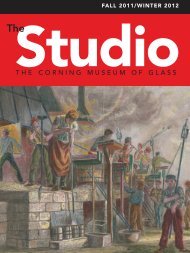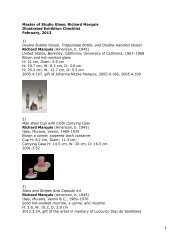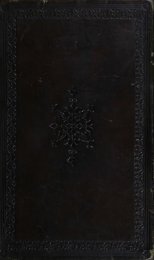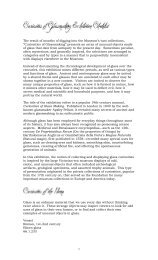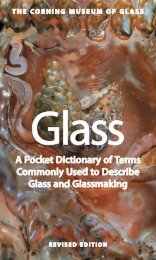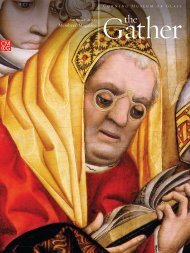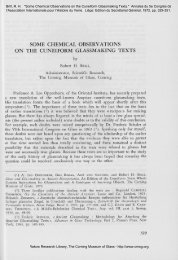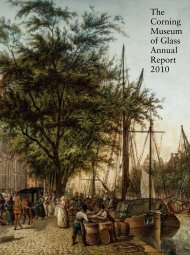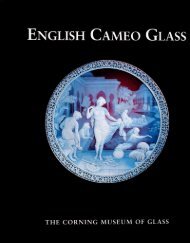"Laboratory Studies of Some European Artifacts Excavated on San ...
"Laboratory Studies of Some European Artifacts Excavated on San ...
"Laboratory Studies of Some European Artifacts Excavated on San ...
Create successful ePaper yourself
Turn your PDF publications into a flip-book with our unique Google optimized e-Paper software.
Brill, R. H., et al. "<str<strong>on</strong>g>Laboratory</str<strong>on</strong>g> <str<strong>on</strong>g>Studies</str<strong>on</strong>g> <str<strong>on</strong>g>of</str<strong>on</strong>g> <str<strong>on</strong>g>Some</str<strong>on</strong>g> <str<strong>on</strong>g>European</str<strong>on</strong>g> <str<strong>on</strong>g>Artifacts</str<strong>on</strong>g> <str<strong>on</strong>g>Excavated</str<strong>on</strong>g> <strong>on</strong> <strong>San</strong> Salvador Island."<br />
Columbus and his World: Proceedings <str<strong>on</strong>g>of</str<strong>on</strong>g> the First <strong>San</strong> Salvador C<strong>on</strong>ference. Ft. Lauderdale, FL:<br />
The Stati<strong>on</strong>, 1987. pp. 247-292. © Gerace Research Centre. Used with permissi<strong>on</strong>. www.geraceresearchcentre.org<br />
The Glass Beads<br />
v<br />
/ The seven glass beads and three fragments are all <str<strong>on</strong>g>of</str<strong>on</strong>g> the same type.<br />
\ (Figures '2)nd 3.) This is a rather distinctive type; <strong>on</strong>ce seen and handled,<br />
- other examples should be easily recognized. On the other hand, without<br />
having examined them, a casual observer could easily be misled into thinking<br />
these beads are the same as other far more familiar and ubiquitous types<br />
<str<strong>on</strong>g>of</str<strong>on</strong>g> seed beads.<br />
The <strong>San</strong> Salvador beads are varieties VIDle and VIDlf in the typology<br />
defined by Marvin Smith and Mary Elizabeth Good in their publicati<strong>on</strong> <strong>on</strong><br />
early Spanish beads found in The New World. 9 The beads corresp<strong>on</strong>d to<br />
nos. 105 and 106 in Figure 7 <str<strong>on</strong>g>of</str<strong>on</strong>g> that publicati<strong>on</strong>. lO The <strong>San</strong> Salvador beads<br />
have a distinct shape and are best described as tiny "ringlets," although they<br />
are not always perfectly round. They are small, measuring <strong>on</strong>ly 2.5-3.5 mm<br />
in "maximum diameter" and have relatively large, roughly circular perforati<strong>on</strong>s<br />
11 ranging from 1.5 to 2.3 mm. Most are somewhat thicker <strong>on</strong> <strong>on</strong>e side<br />
than the other.<br />
These beads were unquesti<strong>on</strong>ably made by winding, as is evidenced by<br />
the internal cords (striati<strong>on</strong>s) which spiral through the bead and around<br />
the axis <str<strong>on</strong>g>of</str<strong>on</strong>g> the perforati<strong>on</strong>. They c<strong>on</strong>tain quite a few seed (small bubbles)<br />
which are generally sphericalized. The seed occasi<strong>on</strong>ally occur in bubble<br />
chains which follow the cord patterns. In all examples there are protrusi<strong>on</strong>s<br />
<strong>on</strong> the thicker porti<strong>on</strong> corresp<strong>on</strong>ding to "winding-thread pull-<str<strong>on</strong>g>of</str<strong>on</strong>g>fs," that is,<br />
places where the thread <str<strong>on</strong>g>of</str<strong>on</strong>g> glass was separated from the main body <str<strong>on</strong>g>of</str<strong>on</strong>g> the<br />
bead during its manufacture. Most <str<strong>on</strong>g>of</str<strong>on</strong>g> these <strong>on</strong>ce had sharp, cracked-<str<strong>on</strong>g>of</str<strong>on</strong>g>f<br />
edges which have since been worn down by erosi<strong>on</strong>, but some were originally<br />
rounded, having become fire-polished during manufacture.<br />
The perforati<strong>on</strong>s are straight-sided and have,surfaces which, weathering<br />
effects aside, are what <strong>on</strong>e expects to see <strong>on</strong> beads wound around a wire.<br />
No traces <str<strong>on</strong>g>of</str<strong>on</strong>g>scale or other metallic corrosi<strong>on</strong> products are preserved <strong>on</strong> the<br />
surfaces, although <strong>on</strong>e bead (5714) does c<strong>on</strong>tain a few black flakes (which<br />
look metallic) trapped inside the glass itself. In places, elliptically-shaped<br />
half bubbles are seen <strong>on</strong> the walls <str<strong>on</strong>g>of</str<strong>on</strong>g> the perforati<strong>on</strong>s. These resulted from<br />
air trapped between the s<str<strong>on</strong>g>of</str<strong>on</strong>g>tened glass and wire when the beads were<br />
wound. The half bubbles are el<strong>on</strong>gated in the directi<strong>on</strong> <str<strong>on</strong>g>of</str<strong>on</strong>g> winding.<br />
The ringlet form <str<strong>on</strong>g>of</str<strong>on</strong>g> these beads is distinctly different from the shape <str<strong>on</strong>g>of</str<strong>on</strong>g><br />
most tiny seed beads - which, by the way, are <str<strong>on</strong>g>of</str<strong>on</strong>g>ten even smaller than the<br />
<strong>San</strong> Salvador beads in outside diameter. The vast majority <str<strong>on</strong>g>of</str<strong>on</strong>g> seed beads·<br />
were made by drawing out hollow tubes <str<strong>on</strong>g>of</str<strong>on</strong>g>glass, giving them a shape which<br />
is usually distinctly drumlike and more cylindrical than the ringlet shape <str<strong>on</strong>g>of</str<strong>on</strong>g><br />
the wirewound <strong>San</strong> Salvador beads. It is fortunate in terms <str<strong>on</strong>g>of</str<strong>on</strong>g> this investigati<strong>on</strong><br />
that the excavated beads have such a distinctive and recognizable form,<br />
for that separates them sharply from the far more abundant drawn beads,<br />
thereby <str<strong>on</strong>g>of</str<strong>on</strong>g>fering greater promise for locating their places and dates <str<strong>on</strong>g>of</str<strong>on</strong>g><br />
manufacture. Moreover, <strong>on</strong>e <str<strong>on</strong>g>of</str<strong>on</strong>g> the colors is also quite unusual. Of the ten<br />
250<br />
Rakow Research Library, The Corning Museum <str<strong>on</strong>g>of</str<strong>on</strong>g> Glass - http://www.cmog.org



